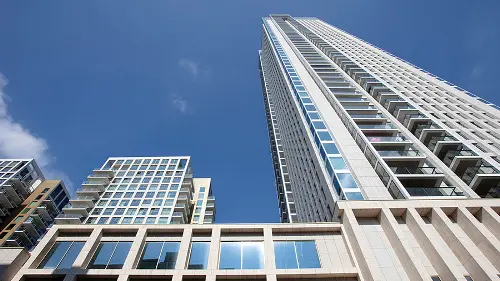Interviewees
Dragana Dukić, Marijana Mandić, Dajana Ostojić-Radovanović
DBA Djordje Bajilo Architects
Award-winning Serbian architecture firm DBA showcases how Mapei's innovative solutions enhance their portfolio, from sports facilities to healthcare centers. Their projects include the Bemax Arena in Montenegro and Indoor swimming pool in Sremska Mitrovica, where systems for waterproofing substrates, installing stone and coating sports surfaces enabled distinctive designs.
What types of projects is your architecture firm involved in?
We are involved in the design of various types of buildings aimed at different sectors such as stadiums, hospitals, schools and residential units and complexes in various parts of Serbia and all across the Balkans area. We work in both the private sector and the public sector.

Dragana Dukić, Marijana Mandić and Dajana Ostojić-Radovanović, DBA Djordje Bajilo Architects
How did the collaboration with Mapei come about?
Mapei guarantees an excellent, constant technical support service during both the design phase and on site. Mapei’s experts are highly competent and are always on hand with suggestions about the most appropriate technologies and products in order to overcome the problems we encounter, looking thoroughly into every situation and proposing innovative solutions. In fact, quite often, we learn about technologies and products we did not know about previously, and that is thanks entirely to Mapei. We used Mapei solutions from the MAPESTONE line, for example, to renovate stone paving on roads in the centre of Novi Sad. We also highly appreciate the waterproofing solutions by Mapei for foundations, swimming pools and roofs, as well as systems for applying thermal insulation on façades or for installing ceramic tiles and stone.
You have been involved in a lot of projects of different types where Mapei solutions have been used. Some of these projects have also received prestigious architecture awards. Can you give us a few examples?
Apart from renovating the stone roads in Novi Sad, we collaborated with Mapei on the design for the Adice Medical Centre in Novi Sad. This structure, inaugurated in March 2022, provides general healthcare services to the local community: this is why we went for an intuitive layout of the spaces, guaranteeing easy access and use of the centre to its users. Its external lines, including those of the roofs, are reminiscent of the architecture of the surrounding houses and, to waterproof the roofs, we used TPO/FPO membranes manufactured by Polyglass (Mapei Group). PVC membranes, again by Polyglass, were also used to waterproof the foundations.
The Adice Centre received the BigSEE Architecture Award in the public and commercial architecture category, a recognition assigned every year to architecture projects in South-eastern Europe that have made a contribution to society from a cultural and social perspective. The project also received the international Architecture Masterprize award for its distinctive use of innovation and creativity amongst projects dedicated to structures for the healthcare sector.

Waterproofing membranes manufactured by Polyglass were used on the roofs and for the foundations of the Adice Medical Centre in Novi Sad designed by DBA architects.
Our project for the Bemax Arena in Podgorica (Montenegro) also included the use of Mapei products. This is a modern, multi-functional structure which started from the redevelopment of an indoor swimming pool built in the 1980’s. The arena has a seating capacity of 2,272 and is used for basketball, volleyball and handball and boxing matches. We used Mapei products from the building line to renovate the spectator stands and a complete system (MAPECOAT TNS URBAN) to create outdoor basketball courts. This project also received an award, this time from the International Association for Sports and Leisure Facilities (IAKS), for the excellence of the design choices which focused on transforming the structure.

In the Bemax Arena Mapei products were used to renovate the spectator stands and a complete system (MAPECOAT TNS URBAN) was chosen to create the surfaces of the outdoor basketball courts.
Mapei solutions were also chosen for the indoor swimming pool sports centre project in Sremska Mitrovica, in Northern Serbia. This sports complex includes three swimming pools designed to meet the needs of the local community and offers a safe, comfortable environment in line with the requirements of FINA (International Swimming Federation), where users of all ages can carry out physical activities or simply relax. In this project we were able to exploit the completeness of Mapei systems which enabled us to guarantee adequate treatment and good waterproofing for the substrates of the swimming pools and flawless installation and grouting of the ceramic coverings.

Mapei products ensured proper treatment and waterproofing of substrates and safe installation of ceramic tiles in the indoor pools in Sremska Mitrovica
What current trends in Serbia are influencing design choices?
There is a tendency to use large format ceramic tiles but, because of their cost, they are only used in high level projects for a specific target group of clients. The same can be said for stone coverings. Local authorities have made a firm commitment to conserving and restoring our historic patrimony, which is one of the reasons for working on projects to redevelop roads in old town centres using systems from the MAPESTONE line and for carrying out work on historic buildings using Mapei materials specific for the restoration and insulation of façades.

The MAPESTONE SYSTEM was used to renovate the paving in Novi Sad city centre.
Why did you decide to visit Marmomac?
Firstly, because we are often involved in landscaping projects which regularly make use of natural stone. Another reason is because we are interested in the use of stone in restoration projects on our cultural and historic heritage, especially projects involving roads and piazzas in old town centres. Natural stone, and not just Italian stone, is well known and highly appreciated in Serbia but, because of its cost, it is only used in buildings of the highest level, such as for entrances, corridors and swimming pools in schools, hospitals and other public and private buildings.




















